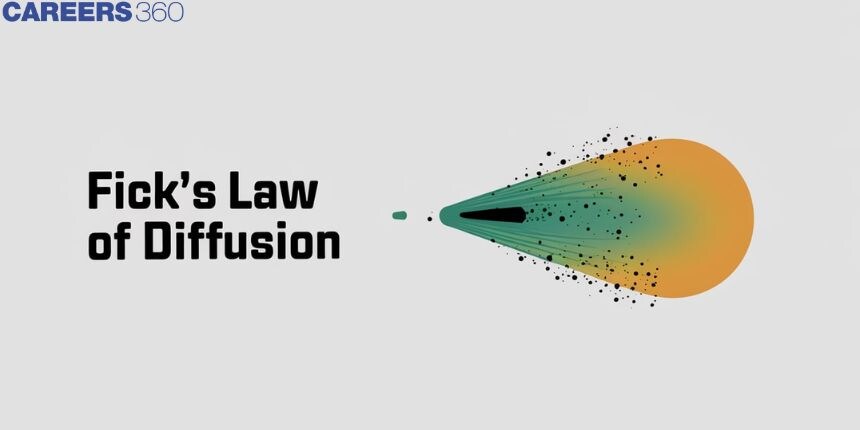Fick's Law of Diffusion - Formula, Application, FAQs
When we dissolve ink in a glass of water, it dissolves in it. Have you ever thought why does that ink drop does not stick at only one place? This phenomenon is due to Diffusion. In this article, we will study about Fick’s Law of Diffusion, Fick’s first law, and Fick’s second law. We will study the application of diffusion in material science and learn the concept of molar flux. But before studying the concept of Fick’s diffusion, we should study the concept of Diffusion.
This Story also Contains
- What is diffusion?
- Molar Flux
- What is Fick’s Law of Diffusion?
- Fick’s first law
- Fick’s second Law
- Application of Fick’s Law

What is diffusion?
Diffusion is a process based on the principle of concentration Gradient. In this process, particles moves from the area of high concentration to low concentration until the concentration on both side becomes equal. It is a fundamental process that occurs in gases, liquids, and solids, driven by the random motion of particles.
Key Characteristics of Diffusion:
- Concentration Gradient: It occurs along a concentration gradient (from high to low).
- No External Energy Required: It does not requires external energy as it is a passive process.
- Random Motion: Particle movement is due to their kinetic energy, motion is random
Examples of Diffusion:
- The process of dissolving sugar in water where sugar particles move from the concentrated area to evenly mix in the water.
- Exchange of oxygen and carbon dioxide in the alveoli of the lungs.
Also Read-
- NCERT Exemplar Solutions for All Subjects
- NCERT Notes For All Subjects
- NCERT Solutions for All Subjects
Before studying Fick’s Law, we should learn about the concept of Molar Flux.
Molar Flux
It is the transfer rate of the moles through a given area per unit time. Chemical engineering, Physics, and thermodynamics commonly use it to describe the flow of substances in processes such as diffusion, convection, or reaction systems.
Mathematically molar flux ( $J$ ) is expressed as:
$$
J=\frac{\text { moles transferred }}{\text { area } \times \text { time }}
$$
Standard unit of Molar flux is: $
\text { moles per square meter per second }\left(\mathrm{mol} / \mathrm{m}^2 \cdot \mathrm{~s}\right) \text {. }
$
What is Fick’s Law of Diffusion?
Fick’s law helps us to understand the process of diffusion in detail. It states that: At any time, molar flux is directly proportional to concentration gradient.
Fick's law Definition- "Fick's law explains how particles spread from an area of high concentration to a low concentration. It shows the rate at which particles move depends on how high the difference in concentration (concentration gradient) is."
In simpler terms we can conclude that:
- Diffusion happens faster if there’s a big difference in concentration.
- Diffusion is slower, if concentration difference is small.
Fick’s first law
Fick’s first law states that the rate of diffusion (flux) is directly proportional to the concentration gradient.
$$
J=-D \frac{d C}{d x}
$$
Where:
- J: Diffusive flux ( $\left.\mathrm{mol} / \mathrm{m}^2 \cdot \mathrm{~s}\right)$ - the number of particles passing through a unit area per unit time.
- D: Diffusion coefficient ( $\mathrm{m}^2 / \mathrm{s}$ ) - how easily particles diffuse.
- $\frac{d C}{d x}$ : Concentration gradient ( $\mathrm{mol} / \mathrm{m}^3 / \mathrm{m}$ ) - the change in concentration over distance.
- The negative sign indicates movement from higher to lower concentration.
Fick’s second Law
Fick’s second Law state that the concentration gradient changes over time due to diffusion. It is applied to positions in the case of unsteady concentration. It changes with time and position.
$$
\frac{\partial \phi}{\partial t}=D \frac{\partial^2 \phi}{\partial x^2}
$$
Where,
- $\partial \phi / \partial t$ is concentration gradient,
- D is diffusivity
Both these formulas are called diffusion formula or fick's law of diffusion formula.
RESULT: We can clearly see concentration gradient is proportional to second derivative of concentration gradient with position.
Application of Fick’s Law
- This works to help design drug release systems such as transdermal patches, which are controlled by diffusion rate.
- Describes how reactants get to reach the surface of catalysts in chemical reactors.
- This works to help design drug release systems such as transdermal patches, which are controlled by diffusion rate.
Frequently Asked Questions (FAQs)
Fick’s law shows diffusion process at macroscopic level. It has two laws and second law is dependent on first law.